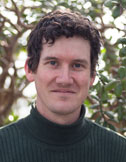Alastair Simpson
 |
PROFESSOR BSc (Sydney, 1994) PhD (Sydney, 2000) |
|||
| Teaching & Research origin and early evolution of eukaryotes, Protistan biodiversity, phylogenetics and systematics, Protistan ultrastructure, and molecular evolution
|
||||
Hess S., Eme L., Roger A.J. & Simpson A.G.B. (2019) A natural toroidal microswimmer with a rotary eukaryotic flagellum. Nature Microbiology. doi: 10.1038/s41564-019-0478-6
Lax G., Lee W.J., Eglit Y. & Simpson A.G.B. (2019) Ploeotids represent much of the phylogenetic diversity of euglenids. Protist, 170, 233-257.
Lax G.*, Eglit Y.*, Eme L.*, Bertrand E. Roger A.J. & Simpson A.G.B (2018) Hemimastigophora is a novel supra-kingdom-level lineage of eukaryotes. Nature, 564, 410-414.
Goodwin J.D., Lee T.F., Kugrens P. & Simpson A.G.B. (2018) Allobodo chlorophagus n. gen n. sp, a kinetoplastid that infiltrates and feeds on the invasive alga Codium fragile. Protist, 169, 911-925.
Buchwald R., Scheibling R.E., & Simpson A.G.B. (2018) Detection and quantification of a keystone pathogen in a coastal marine ecosystem. Marine Ecology Progress Series 606, 79-90.
Heiss, A.A., Kolisko, M., Ekelund, F., Brown M.W., Roger, A.J., Simpson, A.G.B. 2018. Combined morphological and phylogenomic re-examination of malawimonads, a critical taxon for inferring the evolutionary history of eukaryotes. Royal Society Open Science, 10: 171707.
Brown, M.W., Heiss, A.A., Kamikawa, R., Inagaki, Y., Yabuki, A., Tice, A. K., Shiratori, T., Ishida, K., Hashimoto, T., Simpson, A.G.B., Roger, A.J. 2018. Phylogenomics places orphan protistan lineages as deep sisters to Amorphea and identifies a novel eukaryotic super-group. Genome Biology and Evolution, 10: 427-433.
Harding, T. & Simpson, A.G.B. 2018. Recent advances in halophilic protozoa research. Journal of Eukaryotic Microbiology, in press.
Archibald, J.M., Simpson, A.G.B. & Slamovits C. (eds.) 2017. Handbook of the Protists, 2nd edition. Springer. 1657 pp.
Yang, J., Harding, T., Kamikawa, R., Simpson, A.G.B. & Roger A.J. 2017. Mitochondrial genome evolution and a novel RNA editing system in deep-branching heteroloboseids. Genome Biology and Evolution 9: 1161-1174.
Harding, T., Roger, A.J. & Simpson, A.G.B. 2017. Adaptations to high salt in a halophilic protist: Differential expression and gene acquisitions through duplications and gene transfers. Frontiers in Microbiology 8: 944.
Leger, M.M., Kolisko, M., Kamikawa, R., Stairs, C.W., Kume, K., ─îepicka, I., Silberman, J.D., Andersson, J.O., Xu, F. Yabuki, A., Eme, L., Zhang, Q., Takishita, K., Inagaki, Y., Simpson, A.G.B., Hashimoto, T. & Roger, A.J. 2017. Organelles that illuminate the origins of Trichomonas hydrogenosomes and Giardia mitosomes. Nature Ecology and Evolution 1: 0092.
Harding, T., Brown, M., Simpson, A.G.B. & Roger, A.J. 2016. Osmoadaptive strategy and its molecular signature in obligately halophilic heterotrophic protists. Genome Biology and Evolution 8: 2241-2258.
Zhang, Q., T├íborsk├Ż, P., Silberman, J.D., P├ínek, T., ─îepi─Źka, I. & Simpson, A.G.B. 2015. Marine isolates of Trimastix marina form a plesiomorphic deep-branching lineage within Preaxostyla, separate from other known trimastigids (Paratrimastix n. gen.). Protist 166: 468-491
Park, J.S. & Simpson, A.G.B. 2015. Diversity of heterotrophic protists from extremely hypersaline habitats. Protist, 166: 422-437.
Buchwald, R.T., Feehan, C.J., Scheibling, R.E. & Simpson, A.G.B. 2015. Low temperature tolerance of a sea urchin pathogen: implications for benthic community dynamics in a warming ocean.╠ř Journal of Experimental Marine Biology and Ecology, 469: 1-9.
Kirby, W.A., Tikhonenkov, D.V., Mylnikov, A.P., Janou┼íkovec, J., Lax, G., & Simpson, A.G.B. 2015. Characterisation of Tulamoeba bucina n. sp., an extremely halotolerant amoeboflagellate heterolobosean belonging to the Tulamoeba-Pleurostomum clade (Tulamoebidae n. fam.).╠ř Journal of Eukaryotic Microbiology, 62: 227-238.
Lax, G. & Simpson, A.G.B. 2013. Combining molecular data with classical morphology for uncultured phagotrophic euglenids (Excavata); A single-cell approach. Journal of Eukaryotic Microbiology, 60: 615-625.
Brown, M.W., Sharpe, S.C., Silberman, J.D., Heiss, A.A., Lang, B.F., Simpson, A.G.B. & Roger, A.J. 2013. Phylogenomics demonstrates that breviate flagellates are related to opisthokonts and apusomonads. Proceedings of the Royal Society, series B 280: 20131755.
Heiss, A.A., Walker, G. & Simpson, A.G.B. 2013. The microtubular cytoskeleton of the apusomonad Thecamonas, a sister lineage to the opisthokonts. Protist, 164: 598ÔÇô621.
Heiss, A.A., Walker, G. & Simpson, A.G.B. 2013. The flagellar apparatus of Breviata anathema, a eukaryote without a clear supergroup affinity. European Journal of Protistology, 49: 354-372.
Feehan, C.J., Johnson-Mackinnon, J., Scheibling, R.E., Lauzon-Guay, J.-S. & Simpson A.G.B. 2013. Validating the identity of Paramoeba invadens, the causative agent of recurrent mass mortality of sea urchins in Nova Scotia. Diseases of Aquatic Organisms, 103: 209-227.
Adl, S.M., Simpson, A.G.B., & 23 others 2012. The revised classification of eukaryotes. Journal of Eukaryotic Microbiology, 59: 429-514.
Zhang, Q., Simpson, A.G.B. & Song, W. 2012. Insights into the phylogeny of systematically controversial haptorian ciliates (Ciliophora, Litostomatea) based on multigene analyses. Proceedings of the Royal Society, series B., 279: 2625-2635.
Takishita, K., Kolisko, M., Komatsuzaki, H., Yabuki, A., Inagaki, Y., ─îepi─Źka, I., Smejkalov├í, P., Silberman, J.D., Hashimoto, T., Roger, A.J. & Simpson, A.G.B. 2012. Multigene phylogenies of diverse Carpediemonas-like organisms identify the closest relatives of ÔÇśamitochondriateÔÇÖ diplomonads and retortamonads. Protist, 163: 344-355.
Park, J.S. & Simpson A.G.B. 2011. Characterization of Pharyngomonas kirbyi (= ÔÇťMacropharyngomonas halophilaÔÇŁ nomen nudum), a very deep-branching, obligately halophilic heterolobosean flagellate. Protist, 162: 691-709.
Mora, C., Tittensor, D.P., Adl, S., Simpson A.G.B., Worm, B. 2011. How many species are there on Earth and in the Ocean? PLoS Biology 9: e1001127.
Heiss, A.A., Walker, G. & Simpson A.G.B. 2011. The ultrastructure of Ancyromonas, a eukaryote without supergroup affinities. Protist, 162: 373-393.
Kolisko, M., Silberman, J.D., ─îepi─Źka, I., Yubuki, N., Takishita, K., Yabuki, A., Leander, B.S., Inouye, I., Inagaki, Y., Roger, A.J. & Simpson, A.G.B. 2010. A wide diversity of previously undetected relatives of diplomonads isolated from marine/saline habitats. Environmental Microbiology, 12: 2700-2710.
Park, J.S. & Simpson, A.G.B. 2010. Characterisation of halotolerant Bicosoecida and Placididea (Stramenopila) that are distinct from marine forms, and the phylogenetic pattern of salinity preference in heterotrophic stramenopiles. ╠řEnvironmental Microbiology, 12: 1173-1184.
Hampl, V., Hug, L., Leigh, J., Dacks, J.B., Lang, B.F., Simpson, A.G.B. & Roger, A.J. 2009. Phylogenomic analyses support the monophyly of Excavata and robustly resolve relationships among eukaryotic ÔÇťsupergroupsÔÇŁ.╠ř Proceedings of the National Academy of Sciences USA, 106, 3859-64.
Roger, A.J. & Simpson, A.G.B. 2009. Evolution: Revisiting the Root of the Eukaryote Tree. Current Biology, 19, R165-167.
Park, J.S., Simpson, A.G.B., Brown, S. & Cho B.C. 2009. Ultrastructure and molecular phylogeny of two heterolobosean amoebae, Euplaesiobystra hypersalinica gen. et sp. nov. and Tulamoeba peronaphora gen. et sp. nov., isolated from an extremely hypersaline habitat.╠ř Protist, 160, 265-283.
Simpson, A.G.B., Perley,T. & Lara, E. (2008) Lateral transfer of the gene for a widely used marker, alpha tubulin, indicated by a multi-protein study of the phylogenetic position of Andalucia (Excavata). Molecular Phylogenetics and Evolution, 47, 366-377.
Park, J.S., Simpson, A.G.B., Lee, W.J. & Cho, B.C.╠ř2007. Ultrastructure and phylogenetic placement within Heterolobosea of the previously unclassified, extremely halophilic heterotrophic flagellate Pleurostomum flabellatum (Ruinen 1938).╠ř Protist, 158, 397-413.
Park J.S., Cho B.C., and Simpson, A.G.B. 2006. Halocafeteria seosinensis gen et sp. nov. (Bicosoecida), a halophilic bacterivorous nanoflagellate isolated from a solar saltern. Extremophiles, 10, 493-504.
Simpson, A.G.B., Stevens, J.R. & Lukes J. 2006. The evolution and diversity of kinetoplastid flagellates. Trends in Parasitology, 22, 168-174.
Simpson, A.G.B., Inagaki, Y. & Roger, A.J. 2006. Comprehensive multi-gene phylogenies of excavate protists reveal the evolutionary positions of 'primitive' eukaryotes. Molecular Biology and Evolution, 23, 615-625.
Adl, S.M., Simpson, A.G.B., Farmer, M., & 25 others 2005.The new higher-level classification of eukaryotes with emphasis on the taxonomy of protists. Journal of Eukaryotic Microbiology, 52, 399-451.
Simpson A.G.B., Gill E.E., Callahan H.A., Litaker R.W. & Roger A.J. 2004. Early evolution within kinetoplastids (Euglenozoa), and the late emergence of trypanosomatids. Protist 155, 407-422.
Simpson, A.G.B. & Roger, A.J. 2004.The real 'kingdoms' of eukaryotes. Current Biology 14, R693-696.
Simpson A.G.B. & Roger A.J. 2004. Protein phylogenies robustly resolve the deep-level relationships within Euglenozoa. Molecular Phylogenetics and Evolution, 30: 201-212.
Simpson A.G.B. 2003. Cytoskeletal organisation, phylogenetic affinities and systematics in the contentious taxon Excavata (Eukaryota). International Journal of Systematic and Evolutionary Microbiology, 53: 1759-1777.
Simpson A.G.B., Lukes J. & Roger A.J. 2002. Evolutionary history of kinetoplastids, and their kinetoplasts. Molecular Biology and Evolution 19: 2071-2083.
Simpson A.G.B., and Roger A.J. 2002. Eukaryotic evolution: Getting to the root of the problem. Current Biology, 12: 691-693.
Simpson A.G.B., MacQuarrie E.K., & Roger A.J. 2002. Early evolution of canonical introns. Nature 419: 270.
Simpson A.G.B., Roger A.J., Silberman J.D., Leipe, D.D., Edgcomb V.P., Jermiin, L.S., Patterson, D.J. & Sogin M.L. 2002. Evolutionary history of 'early diverging' eukaryotes: The excavate taxon Carpediemonas is a close relative of Giardia. Molecular Biology and Evolution 19: 1782-1791.
Simpson A.G.B. & Patterson, D.J. 1999. The ultrastructure of Carpediemonas membranifera: (Eukaryota), with reference to the 'excavate hypothesis'. European Journal of Protistology 35: 353-370.
Simpson A.G.B. 1997. The identity and composition of the Euglenozoa. Archiv f├╝r Protistenkunde 148: 318-328.

 was born, raised and educated in Sydney, Australia. I finished a PhD in Biology at the University of Sydney in 2000, having also spent several months at the Marine Biology Laboratory at Woods Hole (USA). I came to ┬ÚÂ╣┤ź├Ż in 2000 as a postdoctoral fellow in the Biochemistry Department, and joined the Biology Faculty in July 2003.
was born, raised and educated in Sydney, Australia. I finished a PhD in Biology at the University of Sydney in 2000, having also spent several months at the Marine Biology Laboratory at Woods Hole (USA). I came to ┬ÚÂ╣┤ź├Ż in 2000 as a postdoctoral fellow in the Biochemistry Department, and joined the Biology Faculty in July 2003.